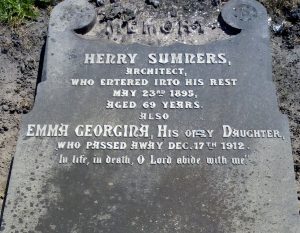Henry Sumners was an architect who designed numerous buildings in Liverpool and the surrounding area in the second half of the nineteenth century.
Sumners was born in 1825, the son of a bootmaker who traded out of 31 Bold Street. On completing his education he was apprenticed to Charles Reed, an architect in Birkenhead and then went to London, working for Charles Barry who at the time was designing the HM Treasury buildings in Whitehall.

In 1848 and 1849 Sumners took an extended tour of Europe, sketching places of interest in France and Italy. On his return to England he entered the competition to design buildings for the Great Exhibition of 1851. Although unsuccessful he was presented with a medal for his efforts and then settled back in Liverpool.
Sumners entered into partnership with another local architect, William Culshaw, in 1861. Amongst their designs by Culshaw & Sumners over the next twelve years were Quarry Bank House in Allerton, Christ Church in Linnet Lane, the Greek Orthodox Church in Princes Road, West Derby Union Workhouse (later Walton Hospital) and Midland Goods Railway offices (now National Museums Liverpool’s conservation centre).
The firm was based in Rumford Court, close to the unofficial Confederate Embassy during the American Civil War (1861-65). It is probably no coincidence then that another building they designed was 19 Abercromby Square, built for Confederate agent Charles K Prioleau.
After Culshaw died in 1874, Sumners practiced alone, his designs including St Cyprians Church in Edge Hill and the buildings for the Liverpool International Exhibition of 1886. He also offered is expertise as a consulting architect, including for the Royal Prince Alfred Hospital in Sydney. Unlike many other businessmen at the time, he never got involved in local politics.
Sumners continued working right up until his death, which occurred at the age of 69 on 23rd May 1895 at 40 Falkner Square. Coincidentally this house had been the final residence of another local architect Peter Ellis, who designed Oriel Chambers in Water Street. He died at the property in 1884. The Liverpool Mercury described Sumners of unassuming disposition and said his demise would be deeply regretted.
After a funeral service conducted by Reverend Ainslee of St Saviours Church in Falkner Square, Sumners was buried at the Necropolis in Low Hill on 27th May. His daughter Emma Georgina remained a spinster all her life and died in 1912. When she was interred at Toxteth Park Cemetery, her father’s name was included on her headstone in memory. At 40 Falkner Square, a blue plaque remembers Ellis but not Sumners.


Love reading your history of those that went before us and helped shape our world